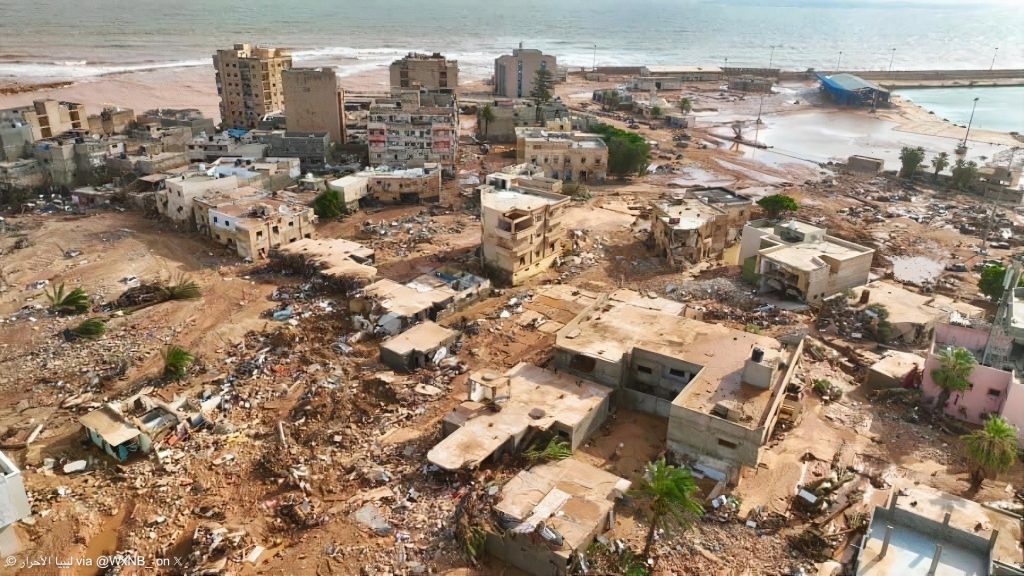The heavy rain brought by Mediterranean Storm Daniel unleashed deadly floods in Libya’s northeast, claiming more than 5,000 lives. The same potent low-pressure system triggered devastating floods in Greece last week.
—
More than 5,000 people are presumed dead after torrential rains from Mediterranean Storm Daniel caused two dams to collapse in northeastern Libya, further intensifying the water flow into regions already submerged by flooding.
Unprecedented floods have struck Libya after the storm – already dubbed the deadliest and costliest Mediterranean tropical-like cyclone ever recorded as well as the deadliest weather event of 2023 to date – made landfall on Sunday. Several cities were affected, including Al-Bayda, Al-Marj, Tobruk, Takenis, Al-Bayada, and Battah, as well as the eastern coast all the way to Benghazi.
Some 10,000 people are estimated to be missing nationwide following the major floods, according to the International Federation of the Red Cross (IFRC).
The collapse of the dams in Derna, a port city of 125,000 inhabitants on the Mediterranean coast, unleashed monstrous torrents of water that destroyed bridges and washed away entire neighbourhoods. Ahmed Mismari, spokesperson for the Libyan National Armi (LNA), estimated that around 5,000-6,000 people were still missing in the city.
According to the Libyan Government of National Unity (GNU), about 300 million dinars (about US$67 million) are needed to rebuild Derna’s road and bridge network, which completely collapsed due to the floods.
More apocalyptic scenes emerging from Derna, Libya courtesy of ليبيا الأحرار
The scale and level of destruction is hard to comprehend. Local reports suggest that 25% of the city has been destroyed or severely damaged. Death toll now exceeds 3,500. pic.twitter.com/PnVyMyTh3x
— Nahel Belgherze (@WxNB_) September 12, 2023
Speaking on Libya’s Almasar TV, health minister in Libya’s eastern administration Othman Abduljalil, who toured the devastated city on Monday, called the situation “catastrophic,” saying that bodies were “still lying everywhere.”
“There are no first-hand emergency services. People are working at the moment to collect the rotting bodies,” Anas Barghathy, a doctor currently volunteering in Derna, told CNN.
Authorities estimate that about 25% of Derna has been completely destroyed, with heavy destruction making it almost impossible for rescue teams to access some areas of the city. Phone lines and internet are down as well, further complicating rescue efforts.
Speaking to Al Jazeera, Derna’s deputy mayor Ahmed Madroud said that many buildings were clustered in narrow streets located close to the river.
“When the river overflowed its banks, it just took all the buildings with it, and the families that were in it,” he explained.
He also blamed the nation’s infrastructure, which has suffered neglect in numerous regions due to the division caused by rival governments, with one governing in the east and the other in the west.
Unprecedented Rain
More than 16 inches (406 millimetres) of rain fell on Bayda, a commercial and industrial city in eastern Libya. The city typically gets about half an inch of rain in a regular September. And in Derna, witnesses said floodwaters were as high as 10 feet (3 metres).
The torrential rain that hit Libya’s northeastern regions is the result of a very strong low-pressure system associated with Mediterranean Storm Daniel – one of the deadliest on record to hit North Africa. The same system brought devastating flooding to Greece last week.
The immense destruction unleashed by Storm Daniel in eastern Libya is truly heartbreaking – so many lives lost and people missing.
The UN is working to address urgent needs on the ground including provision of life-saving support such as food, water, medical supplies and shelter. pic.twitter.com/C4vQ9o43Lb— Georgette Gagnon – جورجيت غانيون (@ggagnonn) September 12, 2023
Storm Daniel “is illustrative of the type of devastating flooding event we may expect increasingly in the future” as the climate crisis intensifies, Lizzie Kendon, a climate science professor at the University of Bristol, has said.
The deadly storm comes in an unprecedented year of extreme weather events and climate disasters. Record-breaking temperatures have made summer 2023 the hottest on record globally “by a large margin,” the EU Earth’s observation Agency Copernicus said last week.
Extreme temperatures did not only affect people around the world but also marine ecosystems, as sea and ocean temperatures reached their warmest surface temperatures on record. August as a whole saw the highest global monthly average sea surface temperatures ever recorded across all months, while daily temperature records were broken every day from July 31 to August 31, according to Copernicus data.
Last month, the Mediterranean Sea’s surface temperature hit 28.7C (83.7F), the highest median recording since at least 1982.
Warm sea water fuels storms, increasing their intensity. Indeed, as the storms travel across warm oceans, they pull in more water vapour and heat, resulting in stronger wind, heavier rainfall, and more flooding when the storms make landfall.
Libya’s storm follows several catastrophic flooding in many other parts of the globe, including Hong Kong last week, which was hit by the heaviest rain in at least 140 years.
Featured image: Libya Alahrar TV/ ليبيا الأحرار/Twitter
You might also like: Climate Finance: Are the Rich Nations Doing Enough?


















